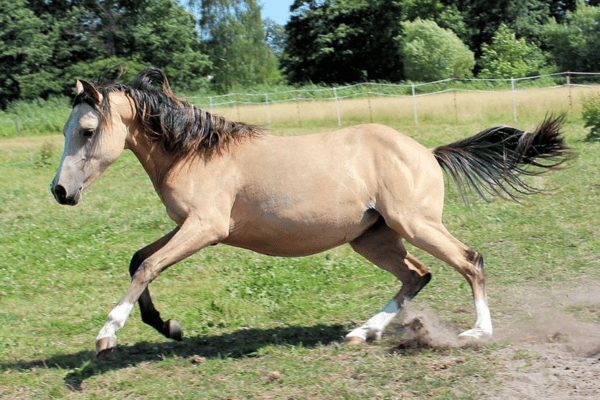From nature’s intricate canvas comes the dun horse: an iconic symbol encapsulating stories, myths and physical attributes that have captured human imagination for millennia. Recognizable by its dilute coat color and conspicuous primitive markings, its significance extends far beyond mere physical attraction to become deeply interwoven into our collective history and culture.
The dun horse carries a unique and recognizable coat color that stands out in the equine world. With a specific dilution gene that affects its coat’s black and red pigments, the dun coat lightens the horse’s overall color while retaining dark markings in specific areas, creating a contrast that is both simple and captivating. Beyond its aesthetic appeal, the dun coat color opens a fascinating window into the world of equine genetics and color variations.
A dun horse proudly flaunts an eye-catching dorsal stripe reminiscent of a dark river running along its back, often enhanced by more profound facial and leg shade that might include transverse stripes across its shoulders or parallel lines etched along its forelegs.
Dun Gene:
Within the world of equine colors, dun genes take center stage by subtly manipulating red and black pigments to craft its signature look. Casting lighter shades across most of their body while keeping their vibrant mane, tail, legs, or archaic markings true to its base coat color.
One can’t fail to recognize a dun horse with its striking dorsal stripe that runs along its spine. Their faces and legs often display darker hues; some even possess horizontal or transverse stripes on their shoulders or forelegs!
Body hue, determined by coat color genetics, shows variance among duns. A “bay dun”, prized for its aesthetic value, may range from sandy yellow to an inviting reddish-brown and sit within the range of tan to gray-gold colors.

Chestnut-based duns offer an airy tan hue, while their black-based counterparts boast an intoxicating, seductive smoky gray hue that jumps off every surface of their coats eloquently reflecting an undiluted base coat color and providing consistency among their many traits.
Engagingly, the dun gene doesn’t work solo: its activity collaborates across alleles to produce an exquisite array of coat colors and patterns across breeds that creates an alluring visual spectacle.
Ancient Roots and Symbolism :
Archeological discoveries have unearthed evidence of dun horses throughout human history. Cave paintings dating back to prehistoric times depict these magnificent animals, attesting to an early connection with our ancestors and this magnificent species.
Ancient Scythians, Mongol warriors and Native American tribes prized dun horses not only for their striking appearance but also because of their robustness and stamina; in various cultures dun horses symbolize power, freedom, spiritual strength as well as often being interwoven with folklore or mythology.
Dun Horses in History and Mythology :
Dun horses have long been revered in history for their unique coat color and markings, which not only added aesthetic value but also provided practical benefits in battles, hunts, travel, etc. You can see evidence of dun horses throughout artifacts from ancient civilizations as well as cave paintings.
Mythology and folklore often ascribe mystical powers to dun horses, lending them symbolic significance in various cultures. Their unique coat and markings – particularly dorsal stripes and any possible zebra-striping on legs – led many cultures to associate dun horses with wildness or supernaturality.
History and mythology have left dun horses as symbols that combine practicality with symbolic meaning. Their physical attributes, resilience, and mysterious coat color not only made them popular during various historical contexts but have become deeply embedded into various cultural mythologies, telling tales of valor, strength and mystic power throughout time.


Horse Breeds That Exhibit Dun Coat Color:
Dun coat colors adorn many breeds of equine breeds with its vibrant, radiant chromatic spectrum, delighting the eye while enhancing genetic artistry across an extensive and varied array of breeds
| American Walking Pony |
| Mustang Horse |
| Kathiawari Horse |
| Appaloosa Horse |
| Florida Cracker Horse |
| Sandalwood Pony |
| Kiger Mustang Horse |
| Georgian Grande Horse |
| Azerbaijan Horse |
| Bosnian Mountain horse |
| Nez Perce |
| North Swedish Horse |
| Scandinavian Coldblood Trotter |
| Icelandic Horse |
| Kerry Bog Pony |
| Australian Pony |
| Missouri Fox Trotter |
| Miyako Pony |
| Andravida Horse |
| Bali Pony |
| German Riding Pony |
| Dulmen Pony |
| Connemara Pony |
| Andalusian Horse |
| Gotland Pony |
| Poitevin Horse |
| Dole Gudbrandsdal Horse |
| Tennessee Walking Horse |
| Boerperd Horse |
| French Saddle Pony |
| Welara Pony |
| Guizhou Pony |
| Canadian Rustic Pony |
| Riwoche Horse |
| Highland Pony |
| Blazer Horse |
| Hucul Pony |
| Faroe Pony |
| Coffin Bay Pony |
| Carolina Marsh Tacky |
| Kentucky Mountain Saddle Horse |
| Peruvian Paso |
| Lokai Horse |
| Nokota Horse |
| Newfoundland Pony |
| Mongolian Horse |
| Indian Country-bred Horse |
| Shetland Pony |
| Morab Horse |
| Mangalarga Marchador Horse |
| Lusitano Horse |
| Deliboz Horse |
| Campolina Horse |
| Irish Draught Horse |
| Sumbawa Pony |
| Ob Pony (Priob) |
| Spanish Jennet Horse |
| Swiss Warmblood (Einsiedler) |
| Heck Horse |
| Lundy Pony |
| Arenberg-Nordkirchener Pony |
| Racking Horse |
| Przewalski’s Horse |
| Highland Pony |
| Pintabian Horse |
| Zemaitukas Pony |
| Spanish Mustang |
| Pryor Mountain Dog |
| Criollo Horse |
| Fjord Horse |
| Konik Horse |



